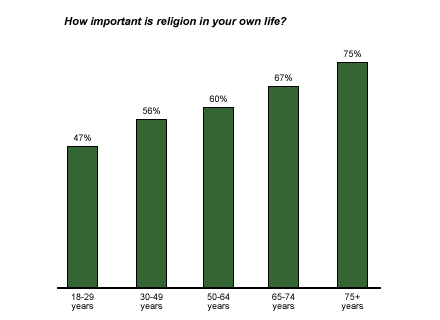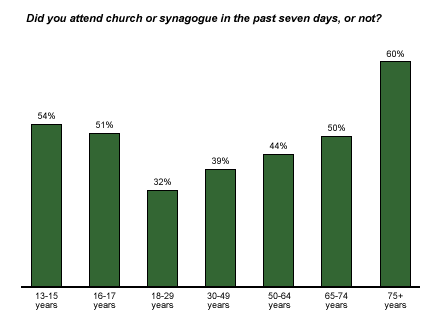Gallup has observed a cyclical ebb and flow in religiosity among Americans since the 1930s, which indicates that Americans find religion early in life and lose some during young adulthood, only to find it again as they mature. According to Gallup's latest research on this subject, this trend continues: U.S. adults tend to grow more religious as they grow older. Although religion plays an important role in the lives of many teen-agers, religiosity tends to drop off as teens enter adulthood, and then gradually increase again as young adults mature. This increase in religiosity continues as adults reach middle and old age.
The Importance of Religion
When asked, "How important is religion in your own life?" in a 2001 Gallup poll*, 47% of young adults (aged 18 to 29) chose "very important." This percentage increases to 56% for 30- to 49-year-olds and 60% for 50- to 64-year-olds. Among respondents 75 years of age and older, the figure reaches 75%.

Gallup Youth Survey data allow for a closer look at teens. Teen-agers (aged 13 to 17) were asked a similar question in a 2000 survey**; the results indicate that teens are more religious during their early teen years, and that religiosity begins to decline as teens near adulthood. When asked, "How important are your religious beliefs?", 63% of 13- to 15-year-olds answered "very important," compared to 52% of 16- to 17-year-olds.
Church Attendance and Membership
Church attendance also drops during the teen and young adult years and begins to climb as adults age. Fifty-four percent of teens aged 13 to 15 reported having attended church in the past seven days, as did 51% of 16- to 17-year-old teens. The figure drops to 32% among 18- to 29- year-olds but rises again to 44% among 50- to 64-year-olds and 60% among those aged 75 and older.

Church membership follows a similar pattern. Sixty-nine percent of 13- to 15-year-olds report being members of a church or synagogue, compared to 59% of 16- to 17-year-olds, 60% of 18- to 29-year-olds, 72% of 50- to 64-year-olds, and 80% of those aged 75 and older.

Belief in a Universal Spirit
While increases in religiosity among older age groups are apparent in terms of the importance of religion, churchgoing and church membership, differences between age groups tend to be fewer and farther between when it comes to basic beliefs. For example, 96% of 18- to 29-year-olds say they believe in God or a universal spirit***, with this percentage remaining statistically unchanged in older age groupings (94% for those aged 30 to 49 and 95% for those aged 50 and older).
Key Points
Gallup has been observing patterns similar to the ones described above for decades. What causes this ebb and flow of religiosity in Americans' lives? Gallup data offer a few insights: young teen-agers' religious beliefs and practices tend to match those of their parents, but that religiosity starts to dip as young people move through their teen years and become more independent. After high school, teens tend to venture away from their families to work or attend college, and religiosity drops even further.
Religion becomes more important again as young adults progress through their 20s, possibly marry, have children and settle down in a community. Many Americans want religion to play a role in their children's lives, and this desire may draw people back into their religious communities. As people grow into their middle years, they begin to experience the loss of parents and increasingly face the inevitable changes of life, which may deepen their religious beliefs even further. As people advance into their final years, they can be expected to be more likely to reflect on the meaning of life, as well as the end of their own.
*Findings are based on the 2001 Gallup Poll Religion Aggregate. Results are based on telephone interviews with 2,035 adults, aged 18 and older, conducted Feb. 19-21, 2001 and Dec. 14-16, 2001. For results based on the total sample, one can say with 95% confidence that the maximum margin of sampling error is ±2%.
**Gallup Youth Survey results based on telephone surveys of approximately 500 teen-agers, aged 13 to 17, conducted in 2000 and 2001. For results based on this sample, one can say with 95% confidence that the margin of sampling error is ±5%.
***Findings are based on telephone interviews with a representative sample of 1,002 adults, aged 18 and older, conducted by The Gallup Organization for The John Templeton Foundation in February 2000.
